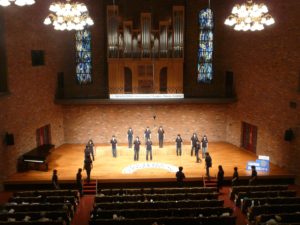La Competencia Internacional 27ma de Coros de Cámara de Takarazuka
Se celebra luego del Gran Terremoto en el Oriente del Japón
 Mitsukazu Suwaki, vicepresidente CICT
Mitsukazu Suwaki, vicepresidente CICT
La Competencia Internacional de Coros de Cámara de Takarazuka, en su vigesimoséptima edición, tuvo lugar los días 23 y 24 de julio de 2011 en la Sala Vega, Takarazuka, Japón, una ciudad localizada entre Osaka y Kobe con 220,000 habitantes. El gran terremoto ocurrido en el oriente japonés el 11 de marzo cobró muchas vidas, forzando la cancelación de una gran cantidad de eventos corales y festivales musicales a través de todo el país, por lo que existió la preocupación de celebrar esta edición del CICT tan próximo al momento del desastre natural. Sin embargo, gracias al gran respaldo recibido, tanto local como del exterior, fue con gran placer que nos dispusimos a celebrarlo. Nos sentimos muy agradecidos por la oportunidad de contar con participantes de las áreas afectadas de Miyagi y Fukushima; estos cantantes nos dijeron que estaban encantados por la oportunidad de participar en el concurso a pesar de haber perdido sus salones de ensayo a consecuencia del tsunami y que, por lo tanto, no habían podido prepararse adecuadamente. Dando una mirada al pasado, nos dimos cuenta de que el éxito del concurso que tuvimos 16 años antes, luego del Gran Terremoto de Hanshin, fue también gracias al apoyo de nuestras sociedades corales, sin importar el daño físico en algunos sectores de Takarazuka y al órgano de tubos que fue severamente dañado en la Sala Vega.
Un total de 22 agrupaciones corales participaron del CICT este año, incluyendo coros de Lituania y Corea, los cuales compitieron en cuatro categorías: Renacimiento / Barroco; Piezas teatrales; Música contemporánea; y Folklore. El coro de la Escuela Superior Aichi ganó el primer lugar absoluto, presentando una gran interpretación con una pieza compuesta por Jozef Karai. El Grupo Coral de Niños de Wakayama obtuvo un segundo lugar en la división de Piezas teatrales. El tercer lugar fue para Asaka Chorverein, provenientes de Tohoku, una de las áreas afectadas por el terremoto.

Por primera vez, en adición al concierto, tuvimos un taller coral de dos días dirigido por Theodora Pavlovitch, quien también fue una de las juezas invitadas del exterior para el CICT. Ella dirigió un coro femenino integrado por 30 voces provenientes de grupos corales de Takarazuka, interpretando una canción folklórica búlgara y su propio arreglo de “I Got Rhythm”, de George Gershwin. Como resultado de su poderoso liderazgo y su sentido del humor, Pavlovitch sustrajo hermosamente las voces del coro en un concierto para el ganador, que se celebra el día final, llevando al CICT a un cierre sumamente aplaudido.

Nos enorgullece haber tenido distinguidos directores corales y agrupaciones corales profesionales del extranjero en la edición de este año, nuestro vigésimo séptimo año. No tan solo ofrecieron magníficas ejecuciones vocales en la Sala Vega, sino que también halagaron el sistema acústico de la sala. Para los coros japoneses, las competencias y los intercambios con coros del exterior tales como el Schola Cantorum Gudanensis (Polonia), Pro Musica Chamber Choir (Suecia), Jauna Muzika (Lituania), Estonia Philharmonic Chamber Choir (Estonia), y el Vancouver Chamber Choir (Canadá) proveen una excelente oportunidad para aprender nuevo repertorio coral. De esta manera, los grupos destacados que representan al Japón, como el Kyoto Academy Choir, el Mulberry Chamber Choir, Vocal Ensemble <EST>, y el Choeur Chêne, se han desarrollado y ahora tienen participación internacional.
También quisiera hacer mención de la nueva categoría “Piezas teatrales”, que comenzó en el 2007. ¿Qué es una “pieza teatral”? Definimos este término como un estilo de ejecución en el cual los cantantes utilizan la totalidad del auditorio de diversas maneras, sin limitarse al escenario para la interpretación. Es común entre las ejecuciones que incluyen actuación que la fuente vocal se pueda localizar en otros lugares de la sala. También puede referirse al uso extendido de otras partes de la sala, como las butacas del público, los pasillos, trasbastidores o los balcones como lugar para cantar. En tales circunstancias, cantar y actuar es generalmente improvisado. El compositor japonés Minao Shibata (1916-1996) fue un pionero de este género. “Oiwake bushikou” (1973) tal y como fue presentada por él, fue creada específicamente como una pieza teatral. El Wakayama Children’s Choral Group, ganador de este año de la categoría “Pieza teatral”, interpretó “Los ojos azules de Dios” (“The Blue Eye of God”) de Nancy Telfer y el “Agnus Dei” de Hideki Chihara, creando exitosamente un hermoso ambiente sonoro que llenó la sala con excelentes voces corales. Esperamos que estos conciertos no se limiten a la competición, sino que también sean nuevas oportunidades para crear su propia música coral.

Finalmente, quisiera expresar mi más sincero agradecimiento por el apoyo tan entusiasta y por las contribuciones tan generosas de nuestros colegas corales del exterior del país para las víctimas del gran terremoto. Hemos recibido este gran apoyo en forma de canción, como en el movimiento “Canta por Japón” (“Sing It for Japan”). El CICT continúa ofreciendo nuestras voces para participar en proyectos que busquen reconstruir las áreas afectadas.
Nos veremos en la edición 28va del CICT, que se llevará a cabo del 21 al 22 de julio de 2012.
Traducido al español por Julio González-Paniagua, Puerto Rico
Edited by Anita Shaperd, USA